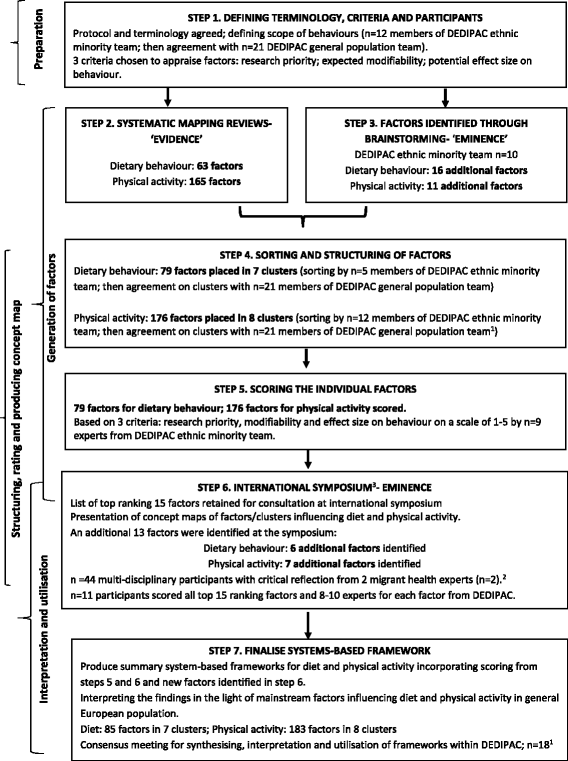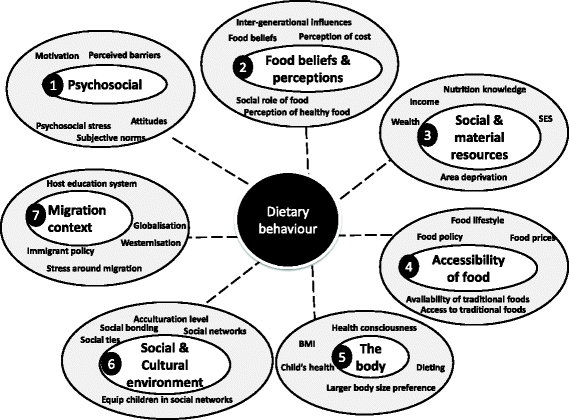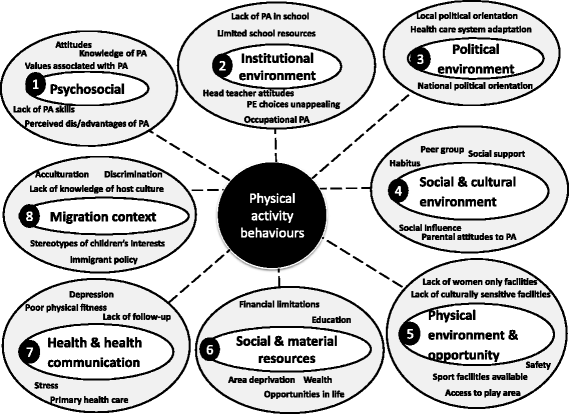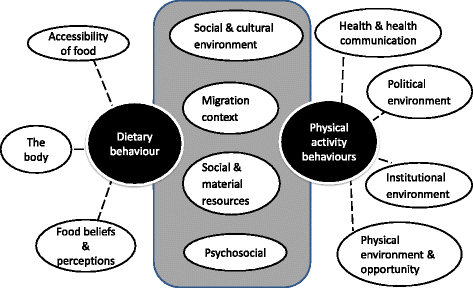Developing a systems-based framework of the factors influencing dietary and physical activity behaviours in ethnic minority populations living in Europe - a DEDIPAC study
- PMID: 29115995
- PMCID: PMC5678802
- DOI: 10.1186/s12966-017-0608-6
Developing a systems-based framework of the factors influencing dietary and physical activity behaviours in ethnic minority populations living in Europe - a DEDIPAC study
Abstract
Background: Some ethnic minority populations have a higher risk of non-communicable diseases than the majority European population. Diet and physical activity behaviours contribute to this risk, shaped by a system of inter-related factors. This study mapped a systems-based framework of the factors influencing dietary and physical activity behaviours in ethnic minority populations living in Europe, to inform research prioritisation and intervention development.
Methods: A concept mapping approach guided by systems thinking was used: i. Preparation (protocol and terminology); ii. Generating a list of factors influencing dietary and physical activity behaviours in ethnic minority populations living in Europe from evidence (systematic mapping reviews) and 'eminence' (89 participants from 24 academic disciplines via brainstorming, an international symposium and expert review) and; iii. Seeking consensus on structuring, rating and clustering factors, based on how they relate to each other; and iv. Interpreting/utilising the framework for research and interventions. Similar steps were undertaken for frameworks developed for the majority European population.
Results: Seven distinct clusters emerged for dietary behaviour (containing 85 factors) and 8 for physical activity behaviours (containing 183 factors). Four clusters were similar across behaviours: Social and cultural environment; Social and material resources; Psychosocial; and Migration context. Similar clusters of factors emerged in the frameworks for diet and physical activity behaviours of the majority European population, except for 'migration context'. The importance of factors across all clusters was acknowledged, but their relative importance differed for ethnic minority populations compared with the majority population.
Conclusions: This systems-based framework integrates evidence from both expert opinion and published literature, to map the factors influencing dietary and physical activity behaviours in ethnic minority groups. Our findings illustrate that innovative research and complex interventions need to be developed that are sensitive to the needs of ethnic minority populations. A systems approach that encompasses the complexity of the inter-related factors that drive behaviours may inform a more holistic public health paradigm to more effectively reach ethnic minorities living in Europe, as well as the majority host population.
Keywords: Diet; Europe; Framework; Immigrants; Migrants; Minority populations; Physical activity; Sedentary behaviour; Systems.
Conflict of interest statement
Ethics approval and consent to participate
This study involved experts in virtue of their training and expertise during an international symposium. Experts have information and knowledge in a substantive area beyond that of the average person and they regularly share this information and knowledge through consultation, teaching or public speaking, or publications and written reports. The Medical Ethics Review Committee of the Academic Medical Center (Netherlands) stated that ethical approval was not required (reference number W16_388 # 16.454) because the
Consent for publication
Not applicable.
Competing interests
The authors declare that they have no competing interests.
Publisher’s Note
Springer Nature remains neutral with regard to jurisdictional claims in published maps and institutional affiliations.
Figures




Similar articles
-
Systematic mapping review of the factors influencing dietary behaviour in ethnic minority groups living in Europe: a DEDIPAC study.Int J Behav Nutr Phys Act. 2016 Jul 28;13:85. doi: 10.1186/s12966-016-0412-8. Int J Behav Nutr Phys Act. 2016. PMID: 27465354 Free PMC article.
-
The SOS-framework (Systems of Sedentary behaviours): an international transdisciplinary consensus framework for the study of determinants, research priorities and policy on sedentary behaviour across the life course: a DEDIPAC-study.Int J Behav Nutr Phys Act. 2016 Jul 15;13:83. doi: 10.1186/s12966-016-0409-3. Int J Behav Nutr Phys Act. 2016. PMID: 27421750 Free PMC article.
-
Hypothetical mechanisms driving physical activity levels in ethnic minority groups living in Europe: a systematically identified evidence-based conceptual systems model.Int J Behav Nutr Phys Act. 2024 Aug 7;21(1):87. doi: 10.1186/s12966-024-01626-2. Int J Behav Nutr Phys Act. 2024. PMID: 39113059 Free PMC article.
-
Using concept mapping in the development of the EU-PAD framework (EUropean-Physical Activity Determinants across the life course): a DEDIPAC-study.BMC Public Health. 2016 Nov 9;16(1):1145. doi: 10.1186/s12889-016-3800-8. BMC Public Health. 2016. PMID: 27825370 Free PMC article.
-
Adapting health promotion interventions to meet the needs of ethnic minority groups: mixed-methods evidence synthesis.Health Technol Assess. 2012;16(44):1-469. doi: 10.3310/hta16440. Health Technol Assess. 2012. PMID: 23158845 Free PMC article. Review.
Cited by
-
Self-Rated Health Among Italian Immigrants Living in Norway: A Cross-Sectional Study.Front Public Health. 2022 Jun 1;10:837728. doi: 10.3389/fpubh.2022.837728. eCollection 2022. Front Public Health. 2022. PMID: 35719667 Free PMC article.
-
Factors influencing dietary behaviours in urban food environments in Africa: a systematic mapping review.Public Health Nutr. 2020 Oct;23(14):2584-2601. doi: 10.1017/S1368980019005305. Epub 2020 May 26. Public Health Nutr. 2020. PMID: 32450938 Free PMC article.
-
International Migration and Cardiovascular Health: Unraveling the Disease Burden Among Migrants to North America and Europe.J Am Heart Assoc. 2024 May 7;13(9):e030228. doi: 10.1161/JAHA.123.030228. Epub 2024 Apr 30. J Am Heart Assoc. 2024. PMID: 38686900 Free PMC article. Review.
-
Socioeconomic inequalities in health-related fitness gradient shifts between 2001 and 2022 in young Polish adults.Front Public Health. 2023 May 9;11:1163215. doi: 10.3389/fpubh.2023.1163215. eCollection 2023. Front Public Health. 2023. PMID: 37228712 Free PMC article.
-
Inequality in physical activity, global trends by income inequality and gender in adults.Int J Behav Nutr Phys Act. 2020 Nov 26;17(1):142. doi: 10.1186/s12966-020-01039-x. Int J Behav Nutr Phys Act. 2020. PMID: 33239036 Free PMC article.
References
-
- Patel J, Vyas A, Cruickshank J, Prabhakaran D, Hughes E, Reddy K, et al. Impact of migration on coronary heart disease risk factors: comparison of Gujaratis in Britain and their contemporaries in villages of origin in India. Atherosclerosis. 2006;185(2):297–306. doi: 10.1016/j.atherosclerosis.2005.06.005. - DOI - PubMed
-
- Leung G, Stanner S. Diets of minority ethnic groups in the UK: influence on chronic disease risk and implications for prevention. Nutr Bull. 2011;36(2):161–198. doi: 10.1111/j.1467-3010.2011.01889.x. - DOI
-
- Hayes L, White M, Unwin N, Bhopal R, Fischbacher C, Harland J, et al. Patterns of physical activity and relationship with risk markers for cardiovascular disease and diabetes in Indian, Pakistani, Bangladeshi and European adults in a UK population. J Public Health. 2002;24(3):170–178. doi: 10.1093/pubmed/24.3.170. - DOI - PubMed
MeSH terms
Grants and funding
LinkOut - more resources
Full Text Sources
Other Literature Sources
Medical

